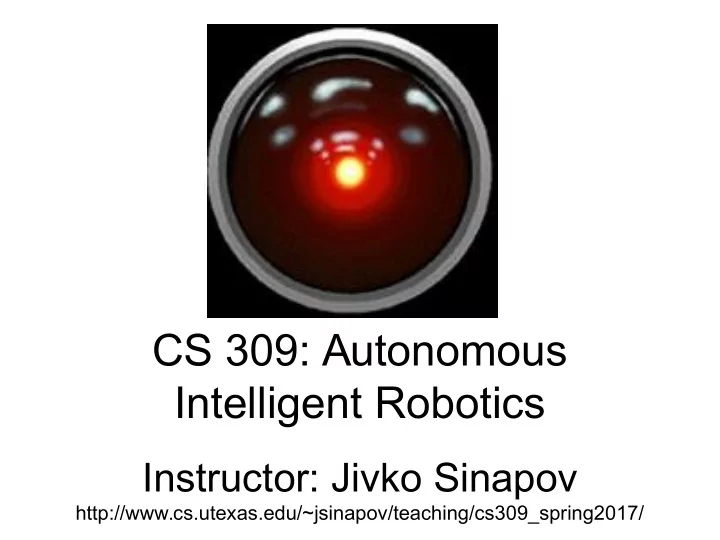

CS 309: Autonomous Intelligent Robotics Instructor: Jivko Sinapov http://www.cs.utexas.edu/~jsinapov/teaching/cs309_spring2017/
Reinforcement Learning
A little bit about next semester... • New robots: robot arm, HSR-1 robot • Virtually all of the grade will be based on a project • There will still be some lectures and tutorials but much of the class time will be used to give updates on your projects and for discussions
Reinforcment Learning
Activity: You are the Learner At each time step, you receive an observation (a color) You have three actions: “clap”, “wave”, and “stand” After performing an action, you may receive a reward
Next time... How can we formalize the strategy for solving this RL problem into an algorithm?
Project Breakout Session Meet with your group Summarize what you've done so far, identify next steps Come up with questions for me, the TAs, and the metors
Main Reference Sutton and Barto, (2012). Reinforcement Learning: An Introduction, Chapter 1-3
What is Reinforcement Learning (RL)?
Ivan Pavlov (1849-1936)
From Pavlov to Markov
Andrey Andreyevich Markov ( 1856 – 1922) [http://en.wikipedia.org/wiki/Andrey_Markov]
Markov Chain
Markov Decision Process
The Multi-Armed Bandit Problem a.k.a. how to pick between Slot Machines (one-armed bandits) so that you walk out with the most $$$ from the Casino . . . . Arm 1 Arm 2 Arm k
How should we decide which slot machine to pull next?
How should we decide which slot machine to pull next? 0 1 1 0 1 0 0 0 50 0
How should we decide which slot machine to pull next? 1 with prob = 0.6 and 0 otherwise 50 with prob = 0.01 and 0 otherwise
Value Function A value function encodes the “value” of performing a particular action (i.e., bandit) Rewards observed when performing action a Value function Q # of times the agent has picked action a
How do we choose next action? • Greedy: pick the action that maximizes the value function, i.e., • ε -Greedy: with probability ε pick a random action, otherwise, be greedy
10-armed Bandit Example
Soft-Max Action Selection Exponent of natural logarithm (~ 2.718) “temperature” As temperature goes up, all actions become nearly equally likely to be selected; as it goes down, those with higher value function outputs become more likely
What happens after choosing an action? Batch: Incremental:
Updating the Value Function
What happens when the payout of a bandit is changing over time?
What happens when the payout of a bandit is changing over time? Earlier rewards may not be indicative of how the bandit performs now
What happens when the payout of a bandit is changing over time? instead of
How do we construct a value function at the start (before any actions have been taken)
How do we construct a value function at the start (before any actions have been taken) Zeros: 0 0 0 Random: -0.23 0.76 -0.9 Optimistic: +5 +5 +5 . . . . Arm 1 Arm 2 Arm k
The Multi-Armed Bandit Problems The casino always wins – so why is this problem important?
The Reinforcement Learning Problem
RL in the context of MDPs
The Markov Assumption The award and state-transition observed at time t after picking action a in state s is independent of anything that happened before time t
Maze Example [slide credit: David Silver]
Maze Example: Value Function [slide credit: David Silver]
Maze Example: Policy [slide credit: David Silver]
Maze Example: Model [slide credit: David Silver]
Notation Set of States: Set of Actions: Transition Function: Reward Function:
Action-Value Function
Action-Value Function Probability of going to Discount factor state s' from s after a (between 0 and 1) The value of taking a' is the action with action a in state s the highest action- value in state s' The reward received after taking action a in state s
Action-Value Function Common algorithms to learn the action-value function include Q-Learning and SARSA The policy consists of always taking the action that maximize the action-value function
Q-Learning Example • Example Slides
Q-Learning Algorithm
Pac-Man RL Demo
How does Pac-Man “see” the world?
How does Pac-Man “see” the world?
The state-space may be continuous... state action reward
How does Pac-Man “see” the world?
Q-Function Approximation a 1 * x 1 + a 2 * x 2 + … + a n * x n
Example Learning Curve Sinapov et al. (2015). Learning Inter-Task Transferability in the Absence of Target Task Samples. In proceedings of the 2015 ACM Conference on Autonomous Agents and Multi-Agent Systems (AAMAS), Istanbul, Turkey, May 4-8, 2015.
Curriculum Development for RL Agents Goal A 54
Curriculum Development for RL Agents Goal Most difficult region A 55
Main Approach . . . . . t-21 t-20 t-19 t 56
Main Approach . . . . . t-21 t-20 t-19 t Rewind back k game steps and branch out 57
Narvekar, S., Sinapov, J., Leonetti, M. and Stone, P. (2016). Source Task Creation for Curriculum Learning. To appear in proceedings of the 2016 ACM Conference on Autonomous Agents and Multi-Agent Systems (AAMAS)
Resources • BURLAP: Java RL Library: http://burlap.cs.brown.edu/ • Reinforcement Learning: An Introduction http://people.inf.elte.hu/lorincz/Files/RL_ 2006/SuttonBook.pdf
THE END
Recommend
More recommend